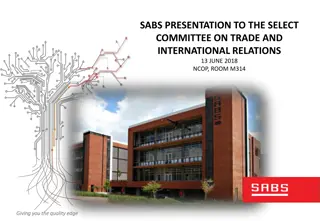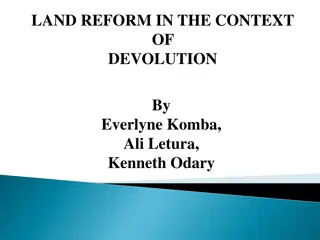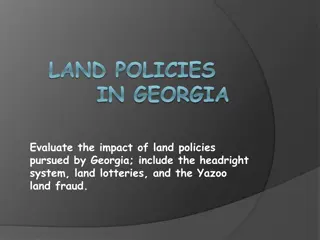Land Reform Mandate and Rural Development Strategies in South Africa
The 1996 Constitution of South Africa outlines the land reform framework, emphasizing equitable access to land for citizens. The 2011 Green Paper on Land Reform emphasizes minimal disruption to agriculture and rural economy transformation. National Development Plan Chapter 6 focuses on rural community empowerment through tourism, agro-processing, and skills transfer. Strategies include education, economic growth, and private sector involvement in land reform initiatives.
Download Presentation

Please find below an Image/Link to download the presentation.
The content on the website is provided AS IS for your information and personal use only. It may not be sold, licensed, or shared on other websites without obtaining consent from the author.If you encounter any issues during the download, it is possible that the publisher has removed the file from their server.
You are allowed to download the files provided on this website for personal or commercial use, subject to the condition that they are used lawfully. All files are the property of their respective owners.
The content on the website is provided AS IS for your information and personal use only. It may not be sold, licensed, or shared on other websites without obtaining consent from the author.
E N D
Presentation Transcript
0 TOURISM TRANSFORMATION SUMMIT 30th & 31stOCTOBER 2017 KOPANONG CONFERENCE CENTRE PRESENTER: MKHACANI-WA-MKHACANI COMMISSION ON RESTITUTION OF LAND RIGHTS
PREAMBLE: LAND REFORM MANDATE 1 The 1996 Constitution sets out the following framework for land reform: That The state must take reasonable legislative and other measures, within its available resources, to foster conditions, which enable citizens to gain access to land on equitable basis (Section 25(5)). A person or community whose tenure of land is legally insecure as a result of past racially discriminatory laws or practices is entitled, to the extent provided by an Act of Parliament, either to tenure which is legally secure or to comparable redress (Section 25 (6)). A person or community dispossessed of property after June 1913 as a result of past racially discriminatory laws or practices is entitled, to the extent provided by an Act of Parliament, either to restitution of that property or to equitable redress (Section 25 (7)). 1
THE PRINCIPLES AND STRATEGIC THRUST OF THE 2011 GREEN PAPER ON LAND REFORM 2 The establishment of DLRCs in each of South Africa s 44 districts form an important part of the legislative and institutional overhaul of the current land reform programme proposed by the 2011 Green Paper. The strategic thrust of the 2011 Green Paper on Land Reform is that land reform should be pursued with minimal disruption to food production and based on the Agrarian Transformation Strategy/ Rural Economy Transformation Model. The Department defines land reform inclusively of the following four functions or pillars: restitution of land rights; redistribution of land; land tenure reform; and land development. The Department further defines the strategic objectives of land reform as two-fold: The principles underlying land reform, as set out in the 2011 Green Paper are to: promote democratic and equitable land allocation; and enhance production discipline in order to promote social cohesion, food security (food sovereignty) and sustainable and shared economic growth through development in rural South Africa. De-racialise the rural economy; rekindling the class of black commercial farmers which was deliberately and systematically destroyed by the 1913 Natives Land Act, as reinforced by subsequent pieces of legislation enacted by successive Colonial and Apartheid regimes. that all land reform farms are 100% productive,
3 3 NATIONAL DEVELOPMENT PLAN CHAPTER 6 The NDP vision 2030 indicated South Africa s rural communities should have greater opportunities to fully participates in the economic, social and political life of the country. People should have access to high quality basic services that enable them to be vibrant, equitable and sustainable rural communities. The driving force behind this will be to support the rural economies in tourism, agro processing, mining, fisheries, etc. The NDP commission recommends that rural development should be based on the following strategies: Provide essential opportunities for education and skills transfer to land reform beneficiaries to promote sustainable and productive land use; In order sustain massive economic growth the industrial development need to be underpinned in areas with greater economic potential such as tourism, fisheries (in coastal areas),and small emerging enterprises. Provide opportunities for white entrepreneurs and the private sector to participate in land reform initiatives so that they can contribute to emerging black entrepreneurs success.
4 4 LAND REFORM PILLARS
LAND REFORM: 5 Key Land reform issues emanating from the Mandate: Land reform is about; Equity in Land ownership and control. Social Justice . Reconciliation and Social cohesion. Pro-poor programme. Sustainable development and productivity. 5
6 INTRODUCTION To date government has redistributed 11 million hectares of Land , 3.2 million hectares of which has been acquired through the land Restitution programme. Tourism is key to sustainable development Comprehensive business models becomes key for tourism sector s radical socio economic transformation. Understanding of the environment and key stakeholders is paramount Collaboration between government sectors and private sector for sustainable projects
THE COMMISSION ON RESTITUTION OF LAND RIGHTS Mandate The Commission on Restitution of Land Rights (CRLR) is a Commission established by the Restitution of Land Rights Act, 1994 (Act No. 22 of1994) as amended. Its mandate is to receive land claims, investigate and resolve the claims through negotiation and mediation or referral to the land Claims Court. Constitutional mandate a person or community dispossessed of property after 19 June 1913 as a result of past racially discriminatory laws or practices is entitled, to the extent provided by an Act of Parliament, either to restitution of that property or to equitable redress. Legislative mandate The Restitution Act empowers the Minister of Rural Development and Land Reform and the Land Claims Court after investigation to make awards to restitution claimants, either restoration of the land claimed, alternative redress through alternative land and or, financial compensation. 7
RURAL ECONOMY TRANSFORMATION: AGRARIAN TRANSFORMATION SYSTEM Roads, bridges, energy, water services, sanitation, library, cr ches, early childhood centres, Police stations, clinics, houses, small rural towns and villages revitalisation. Food Security: Strategic Partnerships: Mentoring Co-management Share equity Modalities being worked out between the Dept and farmers; big and small 8 Tenure System Reform COMMUNITY: LAND: 1. State and Public Land lease hold Social and economic infrastructure, ICT infrastructure, Amenities, Facilities. Tenure system reform, Strategic land reform interventions/redistribution, Restitution, Administration Land based resources. Land Tax 2. Private Land Free hold with limited extent AGRARIAN TRANSFORMATION STRATEGY A rapid and fundamental change in the relations (systems and patterns of ownership and control) of land, livestock, cropping and community. CROPPING: Economic infrastructure: agri-parks, fencing, Inputs: seeds, fertilizer, pesticides, etc Extension support , Fresh produce markets, Credit facilities, Co-operatives Agro-village industries; credit facilities; markets Strengthening of Relative Rights of People Working the Land (50/50 Policy Framework) 3.Foreign land ownership A combination of freehold with limited extent and leasehold; and, 4. Communal land Communal tenure: communal tenure with institutionalized use rights. LIVESTOCK: Economic infrastructure: Processing plants Small industries Abattoirs, animal handling facilities, feed-lots, mechanising stock water dams, dip tanks, silos, windmills, fencing, harvesters, etc 5. Institutions 5.1 Land Management Commission 5.2 Valuer General 5.3 Land Rights Management Board with District and Local Committees 5.4 National Rural Youth Service Corps 5.5 Rural Development Agency with rural cooperatives financing facility 5.6 DLRCs 5.7 NAAC and DAMCs Phase II Phase III Enterprise development One Household One Hectare/ Two Dairy Cows - Programme Rural development measurables Phase I Meeting Basic Human Needs VISION: VIBRANT, EQUITABLE AND SUSTAINABLE RURAL COMMUNITIES
Figure 2 (b): RURAL ECONOMY TRANSFORMATION: COMMUNAL TENURE MODEL COMMUNALLY OWNED: 9 Outer Boundary: Single Title Title Holder: Governance Structure. Roles: Title Holder Adjudication of disputes on land Reference Point Land allocation COMMUNALLY COMMUNALLY OWNED: OWNED: Collective and Collective and individual individual enterprise and enterprise and industrial industrial sector sector 1 1 8 8 HOUSEHOLD HOUSEHOLD SECTOR: SECTOR: Basic unit of Basic unit of production production 1 2 3 Residential Economic Social Services 8 COMMUNITY COMMUNITY- - PUBLIC PUBLIC- -PRIVATE PRIVATE- - COLLABORATION COLLABORATION 7 4 6 5 ROLES: TRADITIONAL COUNCIL/ MUNICIPAL COUNCIL / CPA / TRUST PRINCIPLE: COMPLEMENTARITY ACROSS TRADITIONAL & DEMOCRATIC INSTITUTIONS 9
FIGURE 2 (C) : RURAL ECONOMY TRANSFORMATION: INSTITUTIONAL ROLES AND ROLE-RELATIONSHIPS 10 As set out in the Constitution and the law of the Republic AUTHORITY: THE STATE Traditional Council/ CPA Committee/ Trust, as the case may be. Key elements of accountability: Substantive, NOT numerical quorum Quarterly meetings Annual reports to Parliament via drdlr Regular elections, as defined by the law IDFF: Representative of Households, CPI, Traditional Council, Municipal Council, Local Business, Civic Structures ADMIN. RESPONSIBILITY: GOVERNANCE STRUCTURE INVESTMENT AND DEVELOPMENT FINANCING FACILITY 1 2 3 4 5 6 7 Duties and Services Rights and Responsibilities Opportunities and Constraints INSTITUTIONALISED USE RIGHTS/FULL RIGHTS: Perpetuate the right in law (use rights) Can bequeath the right Can use it as collateral Protection against land sharks: - First right of refusal: household - Second right of refusal: governance structure - Third right of refusal: Govt Active Citizenry and Capable State: The National Development Plan HOUSEHOLDS: Basic Unit of Production and Retailing Manufacturers and Consumers of Goods and Services Rate Payers Voters
11 SHARE-EQUITY ENTERPRISE MODEL BUSINESS OWNERS LANDOWNERS SHAREHOLDERS SHAREHOLDERS HOLDING COMPANY (NEWCO) JV
RESTITUTION TOURISM PROJECTS Land Size (Ha) Number of projects 12 Province Funds Available 4522.92 7 R80 357 650.95 Eastern Cape 2024.5217 1 R0.00 Free State 6716.1379 2 R11 297 820.00 Gauteng 20277.5 8 R11 728 000.00 KwaZulu Natal 43076 10 R6 130 293.00 Limpopo 477789.32 11 R9 916 000.00 Mpumalanga 113250.2 2 R18 000 000.00 Northern Cape 47571.08 12 R68 650 506.00 North West 0 0 R0.00 Western Cape 715297.67 53 R 206 080 269.95 Total
13 KEY CHALLENGES Lack of capacity/ skills to implement the post settlement projects. The projects production level has dropped which puts the economy of the country at stake. No benefit / limited benefit to communities Inadequate support, post settlement strategy and support Lack of co-ordination between the Commission and respective stakeholders in tourism industry (both government and private sector) during the post settlement stage. Community conflicts Proper institutional arrangement and stability.
14 WHAT IS THE SOLUTION? We have an obligation to implement sustainable Restitution projects to contribute towards fulfilling the broad mandate of Land Reform. Sectors collaboration is key The intention is to strengthen our working relationship with DoT for post settlement support Identification of value chains models Our strategic vision is to create vibrant , equitable and sustainable rural communities .























